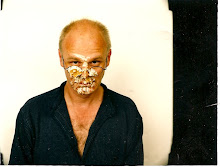By destroying all his work in 1970 John Baldessari added a punctuation mark to his life and work that no reviewer can ignore and every subsequent show must reference. Merely by it’s absence the destroyed work and that moment has become a statement. The paintings which, according to the artist, filled a disused cinema were taken to a nearby crematorium to be disposed of in ritual fashion allowing Baldessari to radically change direction with his work. In the show at Tate Modern we are introduced first, to some of the paintings which ‘survived’ the fire – although I think it would be more fun if they had put some scorch marks around the edges to add a little drama.
These paintings like all of Baldessari’s work are instructive, in fact the whole show feels like an art lesson delivered by a slightly insane but clearly brilliant teacher who has thought of everything and is trying to find a way of showing it all, to everyone, at once. This huge body of work is exhibited chronologically and includes these earlier paintings, photographs, notebooks, video pieces, sketches, montages, diagrams and even a bang-up-to the minute, very large, interactive sculptural installation.
This show is an archive, a reference library for conceptual art and a manual on how to look, how to see and how to deliver.
In a series of small photographs the artist demonstrates hitting various objects with a golf club so that they are in the centre of photograph. These shop-processed prints, like much of the work in this part of the show, have a distinctive period feel as if one had opened a family album full of pictures from that first period of cheaply available, machine processed colour photography. Small prints with uneven colour saturation that have the ubiquitous 1970’s white border and probably have Kodak written in the back. It’s strangely comforting to think there’s probably all the negatives from this part of the show are in the pouch of an envelope with a picture of a smiling family at the beach printed on the front.
This sense of ‘period’ runs throughout the show regardless of whether it is because of the type of print used to make the work which is mostly small 5x3 prints or slightly later 7x5’s but also the subject matter. A long haired Baldessari pronounces I am Making Art in a series of absurd poses adopted for each repetitive line on video shot using the Sony Portapak system developed in the early 1970’s and now transferred to DVD. Everything here is documentation; of it’s time, experiments with new media and of the world within and around the artist. There’s a sense of consistent feedback and reflection in this work which is both cutting-edge and oddly familiar. Baldessari makes it seem as if there is no place he has not been.
The extensive notebooks and preparation documents displayed in glass cabinets mark significant stages in the development of his practice. Each at the initiation of a turning point – demonstrating the meticulous planning and devious intellect behind the simplified ideas that follow. Fable, moral, story, narrative and brainstorming are filed, examined and modified. This is a fascinating insight into the structures which are subsequently released as visual art. This is the cauldron of some mad scientist at work, babbling instructions at his assistants: ‘The best way to do art’ a typical digression into the story of Cezanne while the work of the period (Early 1980’) uses high-contrast pictures taken from film posters or books.
There is a constant increase in scale shown in this relentless progression as if Baldessari has either bought himself a bigger enlarger or has to stand back further to see what he is producing. In addition the reference to the source media and photo-montage material runs awkwardly backwards ¬– the later photographs using images from mid twentieth century film and magazines. He is moving in two artistic and temporal directions at once. Taking the work and it’s transformation forward by utilising paint to obscure and disrupt the ‘disposable’ elements of a photograph, clumsily fucking about with the mounting and framing while incorporating images which are gleaned from an affection for a time which corresponds with his formative years at San Diego State University in the early 1950’s.
The mounting is steadfastly mean – black block-framed prints with no fuss which eliminate sensitivity and are bleakly functional. Each wall space has the feel of a page in a book – and this is essentially where the work is not so much coming from as aiming for. Baldessari is both an art teacher and an artist with loyalties to both which do battle in this huge analysis and leave the observer and student to try and clear up the cognitive mess. The work is uncompromisingly instructional and direct ¬– juxtaposing text with images, pictures with deliberate obfuscation and intentional flaws and then taking the mores of the contemporary establishment, a term which in this case includes over half a century, head-on and confidently offering commentary and response in a positive, and often reactionary way.
The show closes with the viewer reflected in the wall before them, timelapsed by a half minute, standing beneath the gargantuan Baldessari brain formed in plastic like a stage set from the Wizard of Oz where one would expect to find the professor, engineer of ideas and madcap genius standing behind the curtain.




